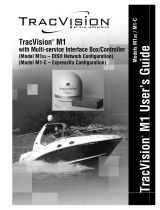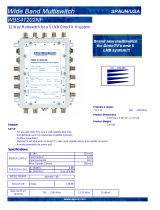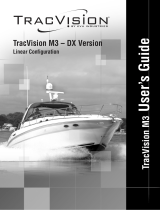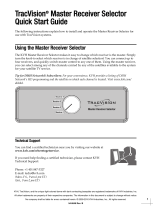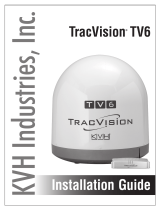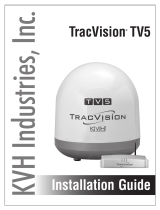Page is loading ...

TracVision M5/M7 User’s Guide
TracVision M5/M7
GyroTrac
™
Configuration

KVH Part # 54-0419-01 Rev. C
© 2007-2008, KVH Industries, Inc., All rights reserved.
U.S. Patents Pending
TracVision M5/M7 User’s Guide
TracVision M5/M7
GyroTrac Configuration
User’s Guide
This user’s guide provides all of the basic information you need to
operate, set up, and troubleshoot the TracVision M5/M7 satellite
TV antenna system. For detailed installation information, please
refer to the TracVision M5/M7 Installation Guide.
Please direct questions, comments, or suggestions to:
KVH Industries, Inc. KVH Europe A/S
50 Enterprise Center Kokkedal Industripark 2B
Middletown, RI 02842-5279 USA 2980 Kokkedal, Denmark
Tel: +1 401 847-3327 Tel: +45 45 160 180
Fax: +1 401 849-0045 Fax: +45 45 160 181
Internet: www.kvh.com Internet: www.kvh.com
If you have any comments regarding this manual, please e-mail
them to [email protected]. Your input is greatly appreciated!

TracVision and KVH are registered trademarks of KVH Industries, Inc.
The unique light-colored dome with dark contrasting base is a registered trademark of KVH Industries, Inc.
DVB (Digital Video Broadcasting) is a registered trademark of the DVB Project.
DIRECTV is an official trademark of DIRECTV, Inc.
DISH Network is an official trademark of EchoStar Communications Corporation.
ExpressVu is a property of Bell ExpressVu, a wholly owned subsidiary of Bell Satellite Services.
All other trademarks are the property of their respective owners.

Table of Contents
TracVision M5/M7 User’s Guide
i
Table of Contents
1Introduction
Using this Manual..............................................................................3
System Overview...............................................................................6
Circular and Linear Versions..............................................................9
2Operation
Receiving Satellite TV Signals .........................................................13
Turning the System On/Off ..............................................................14
Changing Channels and Switching Between Satellites
(Circular Versions) ...........................................................................15
Changing Channels and Switching Between Satellites
(Linear Versions)..............................................................................21
Receiver Requirements ...................................................................24
ADCU Display Types.........................................................................26
Product Care....................................................................................29
3 Settings
Manually Setting Latitude and Longitude ........................................33
Setting the LNB Skew Angle (Linear Versions Only)........................34
Connecting a PC ..............................................................................40
DISH 1000 Setup..............................................................................42
Dual-Sat or Single Satellite Setups .................................................46
European Tri-Sat Mode Setup .........................................................52
Setting Instant On Mode ..................................................................55
Setting Sleep Mode .........................................................................56
Adjusting Display Brightness...........................................................57
Restarting the TracVision System....................................................58

Table of Contents
TracVision M5/M7 User’s Guide
ii
4 Troubleshooting
Five Simple Checks..........................................................................61
Error Messages................................................................................62
Troubleshooting Matrix....................................................................64
Causes and Remedies for Operational Issues..................................65
Technical Support............................................................................69
A Advanced Settings and Functions
Data Output Settings........................................................................73
Setting the Heading Reference Source............................................77
Manually Controlling the Antenna....................................................78
Updating Satellite Frequency Data ..................................................79
Displaying the Calibration Score......................................................81
Displaying the Antenna Software Version........................................82
Displaying the Antenna Serial Number ............................................83
B Recalibration
Recalibrating the System.................................................................87
Setting the Sensor Offset Values .....................................................94
C TracVision M5 Wiring Diagrams
TracVision M5 Wiring Diagram for One or Two Receivers ...............99
TracVision M5 Wiring Diagram for Three or Four Receivers (Circular
Versions Only)*...............................................................................100
D TracVision M7 Wiring Diagrams
TracVision M7 Wiring Diagram for One or Two Receivers .............103
TracVision M7 Wiring Diagram for Three or Four Receivers (Circular
Versions Only)*...............................................................................104
TracVision M7 Wiring Diagram for Three or Four Receivers (Linear
Quad-output Versions Only)*..........................................................105

TracVision M5/M7 User’s Guide
iii
Chapter 1 -
E ADCU Wiring Diagrams
ADCU Wiring Diagram (Required) ..................................................109
ADCU Wiring Diagram (Optional Equipment) .................................110
F Position Grids
European Position Grid ..................................................................113
North American Position Grid ........................................................114

TracVision M5/M7 User’s Guide
1
Chapter 1 - Introduction
1. Introduction
This chapter provides a basic overview of this manual and your
TracVision system.
Contents
Using this Manual.............................................................. 3
System Overview............................................................... 6
Circular and Linear Versions.............................................. 9

TracVision M5/M7 User’s Guide
3
Chapter 1 - Introduction
Using this Manual
This manual provides complete operation, setup, and troubleshooting
information for your TracVision system, as well as wiring diagrams
for various TracVision M5/M7 configurations.
Who Should Use This Manual
The user should refer to the “Operation” chapter to learn how to
operate the system.
The user, installer, or servicing technician should refer to the
“Settings” chapter for information on configuring the system and the
“Wiring Diagrams” appendices for information on connecting
additional receivers.
The user and/or servicing technician should refer to the “Advanced
Settings and Functions” appendix for information on advanced
settings and operational procedures.
The user and/or servicing technician should refer to the
“Troubleshooting” chapter to help identify the cause of a system
problem.
Notifications Used in this Manual
This manual uses the following notifications to call attention to
important information:
NOTE: Notes contain useful information about system settings.
TIP: Tips contain helpful information, allowing you to get the most out of
your TracVision system.
CAUTION
This is a danger, warning, or caution notice. Be sure to read
these carefully to avoid injury!
This is an important notice. Be sure to read these carefully to
ensure proper operation and configuration of your TracVision
system.
IMPORTANT!

TracVision M5/M7 User’s Guide
4
Chapter 1 - Introduction
Typographical Conventions
This manual uses the following typographical conventions:
ADCU (Advanced Digital Control Unit) Interface Conventions
When instructions indicate to select a specific ADCU menu option,
press the ADCU button located directly beneath the menu option.
Figure 1-1 Example of ADCU Menu Option and Corresponding Button
Text Example Description
<SAT NAME>
###
Text in brackets or the pound sign (#) indicates a
variable portion of the Advanced Digital Control
Unit (ADCU) display
HALT
Bold text in capital letters indicates a command
to be entered via a PC
X
Bold text in italicized capital letters indicates a
variable portion of a command to be entered via
a PC
Compass?
Yes Next Return
ADCU

TracVision M5/M7 User’s Guide
5
Chapter 1 - Introduction
Related Documentation
In addition to this User’s Guide, the following documents are
provided with your TracVision system:
Document Description
Installation Guide Complete product installation
instructions
Product Registration Form Details on registering the product
Warranty Statement Warranty terms and conditions
Contents List List of every part supplied in the kit

TracVision M5/M7 User’s Guide
6
Chapter 1 - Introduction
System Overview
Your TracVision M5/M7 is a state-of-the-art, actively stabilized
antenna system that delivers live satellite TV to your vessel’s audio/
video entertainment system. A basic system is illustrated below.
Figure 1-2 TracVision System Diagram (Typical Installation)
TIP: TracVision M5 receiver wiring diagrams are provided in
Appendix C on page 97. TracVision M7 receiver wiring diagrams are
provided in Appendix D on page 101. ADCU wiring diagrams are provided
in Appendix E on page 107.
TracVision Antenna
Advanced Digital
Control Unit (ADCU)
GyroTrac Sensor
Purchased Separately
Vessel Power
12 - 16 VDC
Vessel Power
12 - 16 VDC
Data
Satellite Receiver(s)
TV(s)
Autopilots
GPS or Ship’s Gyro
Plotters
Radars
Remote Displays
Optional Interfaces:

TracVision M5/M7 User’s Guide
7
Chapter 1 - Introduction
System Components
The TracVision M5/M7 includes the following components:
Antenna Unit
The antenna unit houses the antenna positioning
mechanism, LNB (low noise block), and control
elements within a radome. Weathertight
connectors join the power, signal, and control
cabling from the belowdecks units.
GyroTrac Sensor
The GyroTrac digital magnetic compass sensor
provides a three-axis gyro-stabilized heading
reference - allowing superior open water
performance in any sea condition. It is also
compliant with the IP67 standard; the unit is
waterproof to a depth of 1 meter.
ADCU (Advanced Digital Control Unit)
The ADCU is the system’s user interface, providing
access to the system and its functions through an
LCD with three buttons. The ADCU also serves as
the system’s junction box, allowing the system to
interface with the GyroTrac sensor, and supply and
receive data to/from the TracVision M5/M7 and
other onboard equipment.

TracVision M5/M7 User’s Guide
8
Chapter 1 - Introduction
System Features
Your TracVision M5/M7 uses integrated DVB technology to quickly
acquire and track the correct satellite, switch between your selected
satellites, and send TV signals to the receiver.
In-motion Tracking
The TracVision system uses a state-of-the-art, actively stabilized
antenna. Once the satellite is acquired, the antenna’s internal gyros
continuously measure the heading, pitch, and roll of your vessel and
send commands to the antenna motors, keeping the antenna pointed
at the satellite at all times - even while you’re on the move!
Tri-Sat Capability*
When the TracVision system is configured for Tri-Sat operation, you
can track up to three satellites of your choice from the satellite library,
as long as the antenna is located within the satellite’s coverage area.
During installation, your TracVision system should have been set up
to track your desired satellites, allowing you to switch between them
quickly and easily.
Satellite Library
The TracVision M5/M7 includes a pre-programmed satellite library of
the most popular satellite services, offering a wide variety of satellite
services to choose from. For complete information on the satellite
library, see “Settings” on page 31.
TIP: You can add two more satellites of your choice to the satellite library. For
complete information on adding satellites to the library, refer to the associated
Application Note on the KVH Partner Portal (KVH-authorized technicians
only).
Navigational Data
Besides displaying satellite tracking information, the ADCU can also
display navigational data, including magnetic heading, true heading,
pitch, roll, yaw, rate of turn, and latitude and longitude position data.
NOTE: Some displays require an active GPS connection. For more
information on display types, see “ADCU Display Types” on page 26.
*NOTE: Additional hardware is required for DIRECTV Ku-band Tri-sat
capability. Contact KVH Technical Support for details.

TracVision M5/M7 User’s Guide
9
Chapter 1 - Introduction
Circular and Linear Versions
Your TracVision system is configured to receive either circularly
polarized satellite signals (e.g., North America) or linearly polarized
satellite signals (e.g., Europe or Latin America). Figure 1-3 illustrates
the difference between these two polarizations.
Figure 1-3 Polarizations of Satellite Signals
LNB Skew Angle
Since linear satellite signals are oriented in a precise cross pattern, the
TracVision antenna’s receiving element, called an LNB (low-noise
block), must be oriented in the same way to optimize reception. This
orientation adjustment is referred to as the LNB’s “skew angle.”
Figure 1-4 illustrates how skew determines the amount of a linear
signal that the LNB collects. The more signal, the better the reception.
Figure 1-4 How Skew Works
Circular Linear
Signals transmitted in two
“corkscrew” patterns, one
running clockwise and one
running counter-clockwise
Signals transmitted in vertical
and horizontal “waves” offset
exactly 90º from each other
Ideal SkewGood SkewBad Skew
= Satellite Signal = LNB "Signal Collector"

TracVision M5/M7 User’s Guide
10
Chapter 1 - Introduction
The correct skew setting varies depending on your geographic
location, since the orientation of your antenna to the satellite changes
as you move. For example, if your antenna is tracking the PAS 9
satellite for Sky Mexico programming, the ideal skew setting ranges
from +30 to +70, depending upon your location within the satellite’s
coverage area (see Figure 1-5).
Figure 1-5 Approximate Skew Settings for the PAS 9 Satellite
For complete details about adjusting the LNB’s skew, see “Setting the
LNB Skew Angle (Linear Versions Only)” on page 34.
+70
+65
+60
+55
+50 +45 +40 +35 +30

TracVision M5/M7 User’s Guide
11
Chapter 2 - Operation
2. Operation
This chapter explains everything you need to know to operate the
TracVision system.
Contents
Receiving Satellite TV Signals ......................................... 13
Turning the System On/Off .............................................. 14
Changing Channels and Switching Between Satellites
(Circular Versions) ........................................................... 15
Changing Channels and Switching Between Satellites
(Linear Versions).............................................................. 21
Receiver Requirements ................................................... 24
ADCU Display Types......................................................... 26
Product Care.................................................................... 29

TracVision M5/M7 User’s Guide
13
Chapter 2 - Operation
Receiving Satellite TV Signals
Television satellites are located in fixed positions above the Earth’s
equator and beam TV signals down to certain regions of the planet
(not worldwide). To receive TV signals from a satellite, you must be
located within that satellite’s unique coverage area.
TIP: For your convenience, KVH provides links to several websites that offer
satellite coverage information. Simply visit our website at www.kvh.com/
footprint.
Figure 2-1 Location and Coverage Area of DIRECTV 101 Satellite
In addition, since TV satellites are located above the equator, the
TracVision antenna must have a clear view of the sky to receive
satellite TV signals. Anything that stands between the antenna and the
satellite can block the signal, resulting in lost reception. Common
causes of blockage include boat masts, trees, buildings, and bridges.
Heavy rain, ice, or snow might also temporarily interrupt satellite
signals.
Figure 2-2 Example of Satellite Blockage
Equator
TracVision
Blocked!

TracVision M5/M7 User’s Guide
14
Chapter 2 - Operation
Turning the System On/Off
Since power to the TracVision system is controlled by the vessel
power, you can turn the system on or off by applying/removing vessel
power.
Turning On the System
Follow the steps below to turn on your TracVision system.
1. Make sure the antenna has a clear view of the sky.
2. Turn on your satellite TV receiver and TV.
3. If a GPS is connected, ensure the GPS receiver has
obtained an accurate position.
4. Apply operating power to the TracVision system.
TIP: When operating power is applied to the ADCU, the ADCU initiates a
startup sequence. The LCD updates as diagnostic tests are performed.
5. Wait one minute for system startup.The ADCU will
display the Tracking Satellite screen after system self
testing is complete.
Figure 2-3 Tracking Satellite Screen
Turning Off the System
Follow the steps below to turn off your TracVision system.
1. Remove operating power from the TracVision system.
2. Turn off your satellite TV receiver and TV.
Avoid turning the vessel or changing channels for one minute
after turning on the system.
IMPORTANT!
Tracking <Sat A>
<Sat B> Menu <Sat C>
Selected
Satellite
Available Satellites

TracVision M5/M7 User’s Guide
15
Chapter 2 - Operation
Changing Channels and Switching Between Satellites
(Circular Versions)
During installation, your TracVision system should have been set up
to track the satellite(s) of your choice and the channel guides for your
selected satellite service should have been downloaded.
Since some channels might be located on another satellite, changing
channels might require switching between satellites. With most
TracVision configurations, satellite switching occurs automatically
while you change channels using the primary receiver’s remote
control. Find your selected service and configuration in the following
sections for complete details.
TIP: The primary receiver is the receiver connected to the antenna’s RF1
connector.
DISH 1000
When the TracVision M5/M7 system is configured for DISH 1000, you
can view the DISH HDTV programming for your geographic area.
You can configure the system for either DISH 1000/61 or
DISH 1000/129 use.
Figure 2-4 DISH 1000 Configurations
During installation, your TracVision system should have been set to
the DISH 1000 configuration that best suits your geographic location
(see Figure 2-5). If you change satellite coverage areas, refer to “DISH
1000 Setup” on page 42 to change your DISH 1000 configuration.
Figure 2-5 Regional DISH 1000 Configuration Recommendations
Configuration Satellites Tracked
DISH 1000/61 DISH 110, 119, and 61
DISH 1000/129 DISH 110, 119, and 129
= DISH 1000/61 Recommended
= DISH 1000/129 Recommended

TracVision M5/M7 User’s Guide
16
Chapter 2 - Operation
DISH 1000 Automatic Mode - Preferred for One or Two Receivers
The antenna switches between satellites automatically as you change
channels using the primary receiver’s remote control. The primary
receiver is the receiver connected to the antenna’s RF1 cable (see
Figure 2-6 and Figure 2-7). If an optional secondary receiver is
connected, you can use its remote control to switch between the
channels on the currently selected satellite.
Figure 2-6 DISH 1000 Automatic Mode - Receiver Controls
Figure 2-7 DISH 1000 Automatic Mode - ADCU Displays
RF2 RF1
Antenna
GyroTrac SensorADCU
Secondary
Receiver
(optional)
Changes
channels on
current satellite
RF2
Automatically
switches
satellites/channels
Primary Receiver
Grounding
Block
RF1
Tracking DISH 119
110 Menu 61
Available Satellites
(Buttons Not Used)
Selected
Satellite
DISH 1000/61
Tracking DISH 119
110 Menu 129
DISH 1000/129
OR
Available Satellites
(Buttons Not Used)
Selected
Satellite
/
